If you’re looking for a beautiful, easy-to-care-for fish to add to your aquarium, the Black Skirt Tetra is an excellent choice. These fish are hardy, peaceful, and relatively low-maintenance, making them a great option for both beginner and experienced fishkeepers.
Black Skirt Tetras are easy to care for and adapt well to aquarium life. They require a well-planted aquarium with soft, slightly acidic water. They should be kept in groups of at least six and fed a varied diet of high-quality flakes, pellets, and frozen foods. Regular water changes and maintenance are essential for their health.
I first fell in love with Black Skirt Tetras when I saw them swimming gracefully in a friend’s aquarium. Their striking black and silver coloring, combined with their active and playful personalities, immediately caught my attention. Since then, I’ve kept several Black Skirt Tetras in my own tank and have learned a lot about their care and behavior.
In this article, I’ll share everything you need to know about Black Skirt Tetra care, from their ideal tank setup to their diet and breeding habits. Whether you’re a first-time fish owner or a seasoned aquarium enthusiast, you’ll find plenty of useful information to help you keep your Black Skirt Tetras happy and healthy.
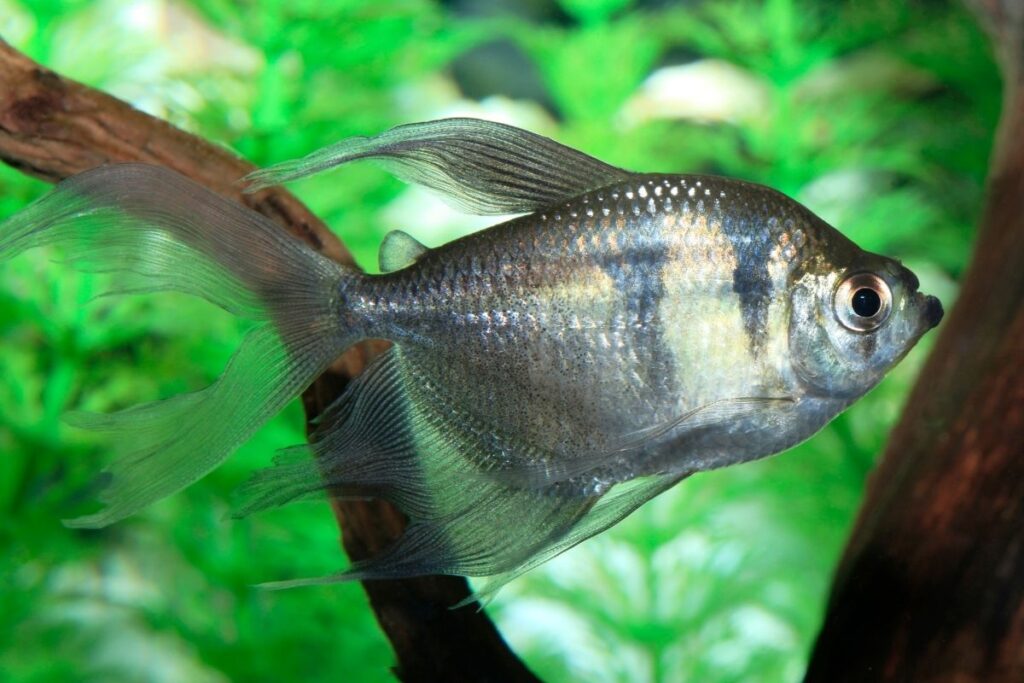
Table of Contents
Species Summary
Black Skirt Tetras are a popular freshwater fish species that are easy to care for and make a great addition to any aquarium.
In this section, we’ll take a closer look at the key characteristics of this species.
Origin
Black Skirt Tetras are native to South America, where they live in slow-moving rivers and streams. They are commonly found in Brazil, Paraguay, and Argentina.
Lifespan
The average lifespan of Black Skirt Tetras is around 3-5 years, although they can live longer with proper care.
Appearance
Black Skirt Tetras are named for their distinctive black coloration on their lower body and fins.
Their upper body is typically silver or gray, and they have a small, pointed mouth.
They are a relatively small species, with adults typically reaching a length of around 2.5 inches.
Size
As mentioned, Black Skirt Tetras typically grow to a length of around 2.5 inches when fully mature. They are a relatively small species, which makes them a great choice for smaller aquariums.
Growth Rate
The growth rate of Black Skirt Tetras can vary depending on a number of factors, including water quality, diet, and tank size.
Generally speaking, they are a relatively slow-growing species.
Behavior & Temperament
Black Skirt Tetras are a peaceful species that get along well with other peaceful fish species.
However, they can become aggressive towards their own kind if kept in a small tank or if there are too many males in the tank.
They are also known for their playful and active nature, which makes them a joy to watch in the aquarium.
Male vs Female
Male Black Skirt Tetras are typically smaller and more slender than females. Additionally, males may have more pronounced fin extensions than females.
Personally, I have found Black Skirt Tetras to be a great addition to my aquarium. They are easy to care for and have a fun and playful personality that makes them a joy to watch.
If you’re looking for a small and peaceful species to add to your aquarium, Black Skirt Tetras are definitely worth considering.
Tank Setup
Setting up a tank for your Black Skirt Tetra is an important step in ensuring their health and happiness. Here are some key factors to consider:
Tank Size
Black Skirt Tetras are small fish, so a tank size of at least 20 gallons is recommended for a small school of 5-6 fish.
A larger tank will provide more swimming space and reduce the risk of aggressive behavior.
Lighting
Black Skirt Tetras do not have specific lighting requirements, but a regular day and night cycle is important for their overall health.
A timer can be used to ensure consistent lighting.
Filtration & Aeration
A good filtration system is essential for maintaining water quality and keeping your fish healthy.
Aeration can also be beneficial, especially if you have a heavily planted tank or if the water flow from the filter is not sufficient.
Heater
Black Skirt Tetras are tropical fish and require a consistent water temperature between 74-78°F.
A reliable heater and thermometer are necessary to maintain this temperature.
Substrate
A fine-grained substrate is recommended to prevent injury to your fish’s delicate fins.
Sand or small-grained gravel are good options.
Decoration
Black Skirt Tetras enjoy having hiding places and areas to explore.
Decorations such as rocks, caves, and driftwood can provide these areas while also adding aesthetic value to your tank.
Plants
Live plants can provide additional hiding places and improve water quality by absorbing nitrates.
However, plastic plants can also be used if you prefer a low-maintenance option.
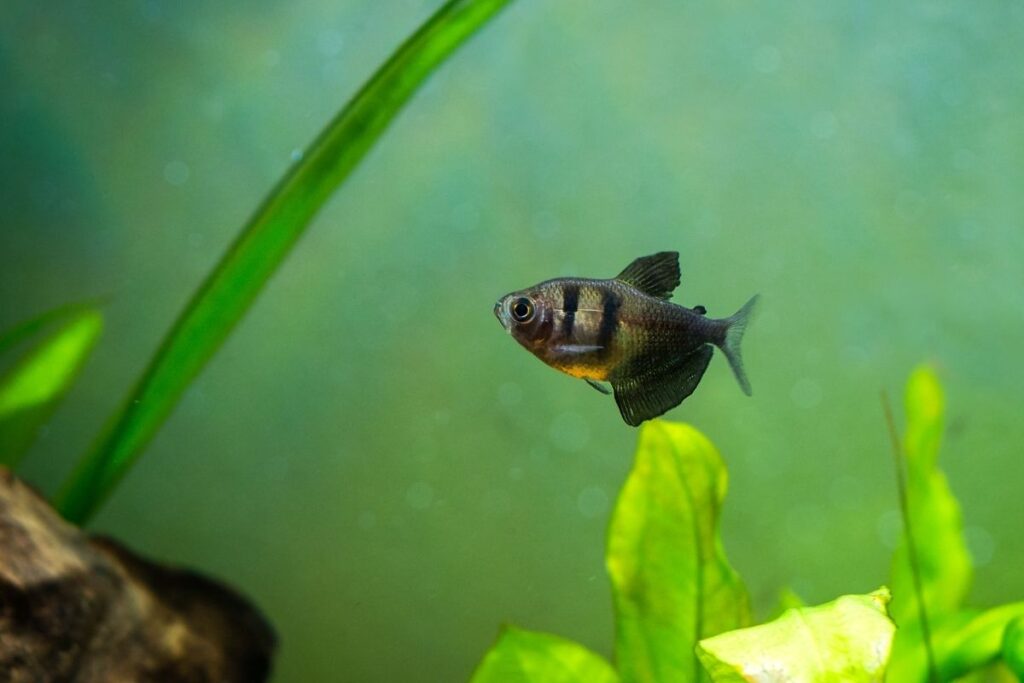
When I set up my tank for my Black Skirt Tetras, I made sure to provide plenty of hiding places and decorations.
I also added a few live plants to help with water quality. Since then, my fish have been happy and active!
Water Quality
As an experienced fish keeper, I know that maintaining the right water quality is essential for keeping Black Skirt Tetras healthy and happy.
Here are the four key factors you need to consider:
Water Temperature
Black Skirt Tetras are tropical fish and require a consistent water temperature of between 72°F and 78°F (22°C to 26°C).
I use a heater in my aquarium to keep the temperature stable, and I recommend investing in a reliable thermometer to monitor the water temperature.
Water pH
Black Skirt Tetras prefer slightly acidic water with a pH level between 6.5 and 7.0. I use a pH test kit to check the water regularly and adjust it as needed using a pH buffer solution.
It’s essential to avoid sudden changes in pH levels, as this can stress the fish and make them more susceptible to illness.
Water Hardness
Black Skirt Tetras prefer soft to moderately hard water with a hardness level between 5 and 12 dGH.
I use a water hardness test kit to monitor the water and make adjustments as needed using a water conditioner. It’s important to avoid using hard water, as this can cause health problems for the fish.
Water Changes
Regular water changes are essential for maintaining good water quality in your Black Skirt Tetra aquarium.
I recommend changing 20% of the water every week using a siphon to remove any debris from the substrate.
It’s important to avoid changing too much water at once, as this can disturb the balance of the aquarium and stress the fish.
By paying close attention to these four factors, you can provide your Black Skirt Tetras with the optimal water quality they need to thrive.
Remember to test the water regularly, make adjustments as needed, and keep up with regular water changes to ensure your fish stay healthy and happy.
Tank Maintenance
As an avid fish enthusiast, I know that keeping a clean and well-maintained tank is essential for the health and happiness of your Black Skirt Tetras.
Here are some tips on how to properly maintain your tank:
First and foremost, it’s important to regularly check the water parameters of your tank. This includes testing the pH, ammonia, nitrite, and nitrate levels.
I recommend testing your water at least once a week to ensure that the levels are within a safe range for your fish.
In addition to testing the water, it’s also crucial to perform regular water changes. I typically change out about 25% of the water in my tank every two weeks.
This helps to remove any excess waste or debris that may have accumulated in the tank, which can be harmful to your fish if left unchecked.
Another important aspect of tank maintenance is cleaning the filter. I make sure to clean my filter at least once a month to prevent any buildup of debris or waste.
This helps to ensure that the filter is functioning properly and providing adequate filtration for the tank.
Finally, it’s important to keep the tank itself clean and free of any algae or other debris. I recommend using an algae scraper or brush to clean the walls of the tank as needed, and to remove any excess debris from the substrate.
Overall, proper tank maintenance is essential for the health and happiness of your Black Skirt Tetras.
By testing the water regularly, performing regular water changes, cleaning the filter, and keeping the tank clean, you can ensure that your fish are living in a safe and healthy environment.
Tank Mates
Compatible Fish Species
When it comes to keeping Black Skirt Tetras, you want to make sure you have the right tank mates.
I’ve found that other peaceful fish species work well, such as neon tetras, guppies, and corydoras catfish. These fish are all small, active, and peaceful, which makes them great companions for Black Skirt Tetras.
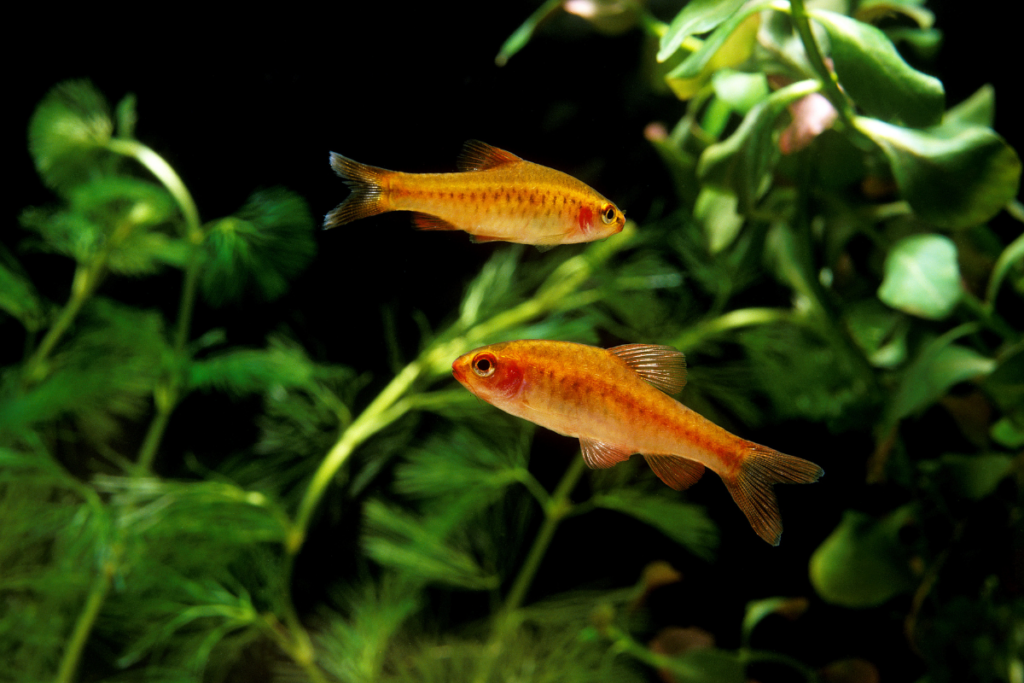
Another fish that I’ve had success keeping with Black Skirt Tetras is the cherry barb.
These fish are also peaceful and have a similar temperament to Black Skirt Tetras. They’re also very colorful, which adds some variety to your tank.
Incompatible Fish Species
While Black Skirt Tetras are peaceful, there are some fish species that you want to avoid keeping with them. I’ve found that aggressive fish, such as cichlids and bettas, can be a problem.
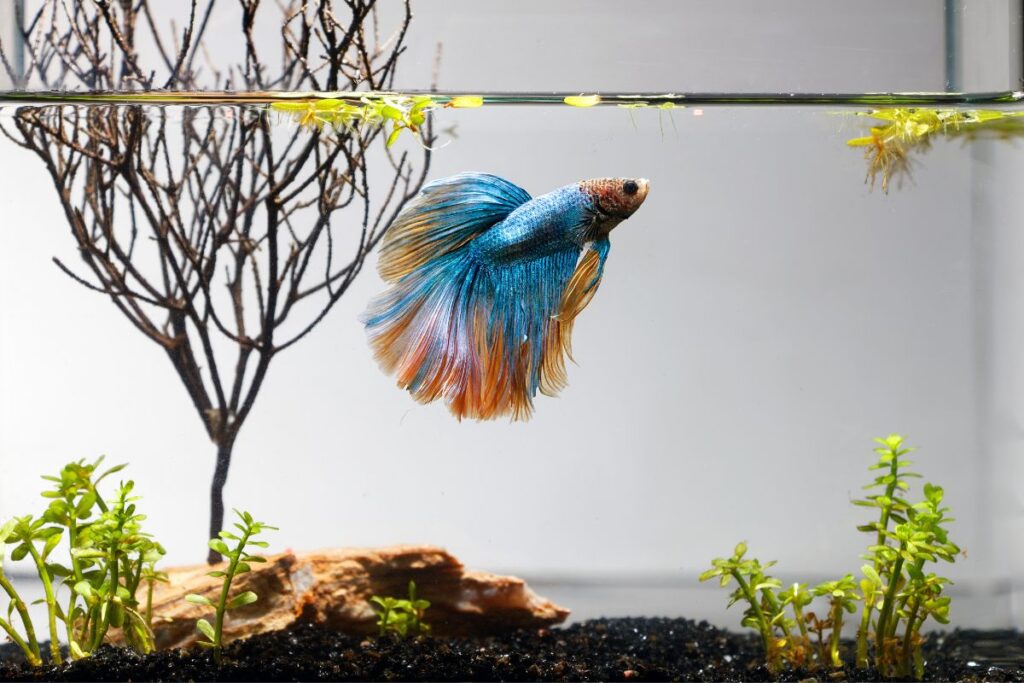
These fish can be territorial and may attack your Black Skirt Tetras.
You also want to avoid keeping fin-nipping fish with Black Skirt Tetras. Fish such as tiger barbs and serpae tetras are known to nip at the fins of other fish, which can stress out your Black Skirt Tetras.
How Many Black Skirt Tetras Should be Kept Together
When it comes to keeping Black Skirt Tetras, you want to make sure you have the right number. I’ve found that a group of six is a good number to start with.
Black Skirt Tetras are social fish and like to be in groups, so having a group of six will allow them to establish a hierarchy and feel more comfortable.
It’s important to note that you don’t want to overcrowd your tank. A good rule of thumb is to have one inch of fish per gallon of water.
So, if you have a 20-gallon tank, you don’t want to have more than 20 inches of fish in the tank. Keep this in mind when deciding how many Black Skirt Tetras to keep.
Personally, I’ve had success keeping Black Skirt Tetras with neon tetras and corydoras catfish. They all get along well and create a beautiful and peaceful tank. Remember to choose your tank mates carefully and keep an eye on their behavior to ensure they’re all getting along.
Diet
Feeding your Black Skirt Tetra is an essential part of their care. A balanced diet is necessary to keep them healthy and happy.
In this section, I will cover what to feed, frequency, and tips to ensure your Tetra is getting the nutrition they need.
What To Feed
Black Skirt Tetras are omnivores, meaning they eat both plant and animal matter. Their diet should consist of a variety of foods to ensure they get all the necessary nutrients.
I feed my Tetras a mix of high-quality flakes, pellets, and frozen foods.
I like to switch up the type of food I give them to keep things interesting. Some of their favorites include brine shrimp, bloodworms, and daphnia.
I also give them some fresh vegetables, like blanched spinach or zucchini, as a treat.
Frequency
It’s important not to overfeed your Tetras, as this can lead to health problems.
I usually feed my Tetras twice a day, in the morning and evening. I give them only what they can eat in 2-3 minutes, and I remove any uneaten food after that time.
This helps prevent overfeeding and keeps the water quality in check.
Tips
Here are some tips to keep in mind when feeding your Black Skirt Tetra:
- Make sure the food is appropriate for their size. Small pellets or flakes are best for Tetras.
- Don’t feed them too much at once. It’s better to feed small amounts multiple times a day.
- Provide a variety of foods to ensure they get all the necessary nutrients.
- Remove any uneaten food after a few minutes to prevent it from fouling the water.
By following these tips, you can ensure your Black Skirt Tetra is getting a balanced and healthy diet. Remember, a healthy diet is essential for their overall well-being.
Personally, I love watching my Tetras eat. They are so active and playful, and it’s fun to see them chase after their food. It’s also a good opportunity to observe their behavior and make sure they are healthy. I hope this section has been helpful in understanding how to properly feed your Black Skirt Tetra.
Common Diseases
Diseases
I have found that Black Skirt Tetras are generally hardy fish, but like any other fish, they are not immune to diseases.
Some of the most common diseases that can affect Black Skirt Tetras include:
- Ich (White Spot Disease)
- Fin Rot
- Columnaris
- Velvet Disease
If you notice any signs of illness in your Black Skirt Tetra, it is important to act quickly to prevent the disease from spreading to other fish in your tank.
Symptoms
The symptoms of these diseases can vary, but some common signs to look out for include:
- White spots on the fish’s body and fins (Ich)
- Decaying or frayed fins (Fin Rot)
- White or grayish patches on the fish’s body (Columnaris)
- Yellowish or brownish-gold dust-like spots on the fish’s body (Velvet Disease)
If you notice any of these symptoms, it is important to take action immediately to prevent the disease from spreading.
Treatment
If you suspect that your Black Skirt Tetra has a disease, you should isolate the fish in a separate tank to prevent the disease from spreading to other fish.
Consult with a veterinarian or a fish expert to determine the best course of treatment for the specific disease.
Treatments can include medication, water changes, and other measures to help the fish recover. Be sure to follow the instructions carefully and monitor the fish’s progress closely.
Prevention
The best way to prevent diseases in your Black Skirt Tetras is to maintain a clean and healthy environment in your tank.
This includes regular water changes, proper filtration, and avoiding overfeeding.
It is also important to quarantine any new fish before introducing them to your tank to prevent the spread of disease. By taking these preventive measures, you can help ensure the health and well-being of your Black Skirt Tetras.
Personally, I have had to deal with Ich in my Black Skirt Tetras before. It was a stressful experience, but with quick action and the right treatment, my fish were able to recover. Remember to always stay vigilant and take action at the first sign of illness to keep your fish healthy and happy.
Signs of a Healthy Black Skirt Tetra
As a proud owner of Black Skirt Tetras, I have learned a lot about their care and well-being. Here are some signs to look for to ensure that your tetra is healthy and happy:
- Bright and Vibrant Color: A healthy Black Skirt Tetra should have a bright and vibrant color. The black stripes on their body should be deep and rich in color, and their fins should be fully extended.
- Active and Energetic: A healthy tetra should be swimming around actively and energetically. They should not be sitting at the bottom of the tank or hiding behind plants.
- Clear Eyes: The eyes of a healthy Black Skirt Tetra should be clear and free from cloudiness or discoloration.
- Healthy Appetite: A healthy tetra should have a healthy appetite and eagerly eat the food you provide. They should not be refusing food or showing signs of disinterest.
- Clean Fins and Scales: A healthy Black Skirt Tetra should have clean and smooth fins and scales. There should be no signs of damage, discoloration, or growths.
By observing these signs, you can ensure that your Black Skirt Tetra is healthy and happy.
Remember to provide them with a clean and well-maintained tank, a balanced diet, and plenty of space to swim around. With proper care, your tetra can live a long and happy life in your aquarium.
Signs Your Black Skirt Tetra is Sick
As a fish owner, it’s important to keep a close eye on your Black Skirt Tetra’s behavior and appearance to ensure they are healthy. Here are some signs that your fish may be sick:
- Loss of appetite: If your Black Skirt Tetra is not eating or showing interest in food, it could be a sign of illness.
- Erratic swimming: If your fish is swimming in a strange, jerky manner or appears to be struggling to swim, it could be a sign of illness.
- Changes in color: If your Black Skirt Tetra’s color appears to be fading or changing, it could be a sign of illness.
- Visible signs of disease: Look for any visible signs of disease, such as white spots or lesions on the fish’s body.
If you notice any of these signs, it’s important to take action quickly to help your fish recover.
The first step is to check the water quality and make sure it’s within the appropriate range for your fish.
If the water quality is good, you may need to consider treating your fish with medication or seeking the advice of a veterinarian.
Personally, I once noticed that one of my Black Skirt Tetras was not swimming as actively as the others and was spending most of its time at the bottom of the tank.
Upon closer inspection, I noticed that it had a white spot on its body. I immediately treated the tank with medication and monitored the fish closely. Thankfully, it made a full recovery and was soon swimming happily with the rest of the group.
Breeding
Breeding Setup
Before starting the breeding process, it is important to set up the right environment for your Black Skirt Tetras. I recommend using a separate breeding tank, which should be at least 10 gallons in size.
The water in the breeding tank should be soft and slightly acidic, with a pH level between 6.5 and 7.0.
You should also provide plenty of hiding places for the fish, such as plants and rocks. A dimly lit environment can also help induce breeding.
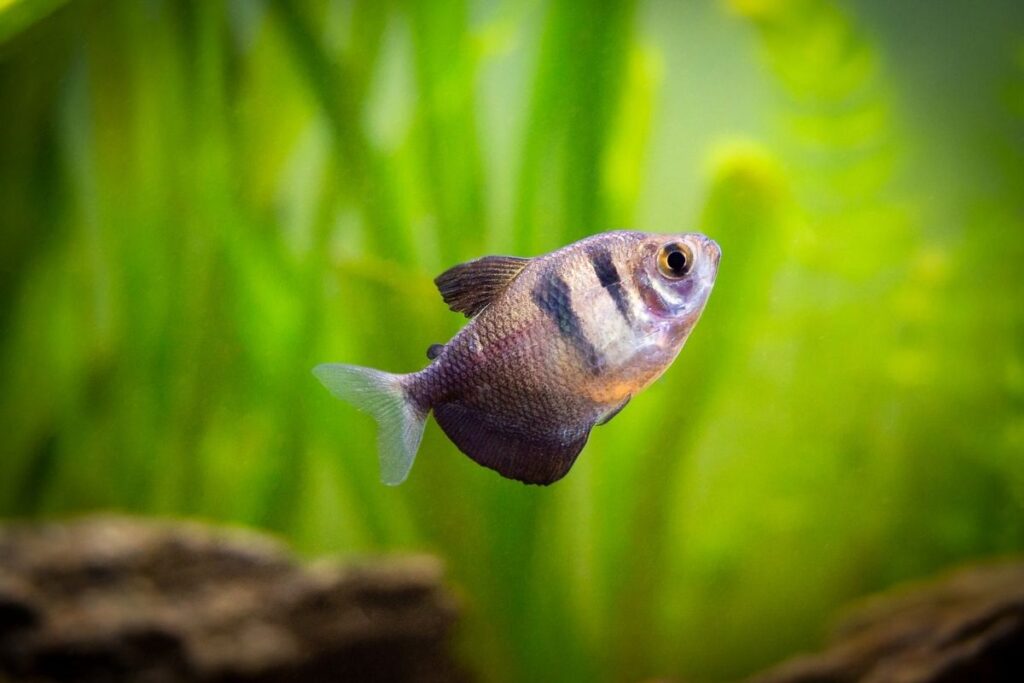
How To Breed
Breeding Black Skirt Tetras can be a bit of a challenge, but it is definitely worth the effort. To initiate breeding, you will need to introduce a male and a female into the breeding tank.
Once the fish have acclimated to the new environment, you can start to observe their behavior. If the male is interested in breeding, he will start to chase the female around the tank.
Eventually, the female will lay her eggs, which the male will then fertilize.
After the eggs have been fertilized, you should remove the adult fish from the breeding tank to prevent them from eating the eggs.
The eggs will hatch in about 24-48 hours, and the fry will start to swim freely after another 3-4 days.
During this time, it is important to feed the fry small amounts of food several times a day, such as baby brine shrimp or crushed flakes.
Care
Once the fry have hatched, you should keep a close eye on their development. It is important to maintain the right water conditions, as well as to provide them with plenty of food and hiding places.
As the fry grow, you can gradually introduce them to larger tanks and start to feed them more substantial foods, such as small pellets or live foods.
Personally, I have found that breeding Black Skirt Tetras can be a very rewarding experience. I remember the first time I successfully bred a pair of these fish, and how excited I was to see the fry hatch and grow. If you are patient and persistent, you too can enjoy the experience of breeding these beautiful fish.
Product recommendations for Black Skirt Tetra:
- TetraMin Plus Tropical Flakes– This is a high-quality fish food that is perfect for black skirt tetras. It contains all the essential nutrients that your fish need to stay healthy and vibrant.
- API Aquarium Water Test Kit – It is important to keep an eye on the water quality in your aquarium, and this test kit makes it easy to do so. It includes tests for ammonia, nitrite, nitrate, and pH.
- Seachem Prime – This is a water conditioner that helps to detoxify ammonia, nitrite, and nitrate in your aquarium. It is safe for use with black skirt tetras and other fish.
- Hikari Micro Pellets – These small pellets are perfect for black skirt tetras, as they are easy to digest and contain a balanced mix of protein, fat, and fiber.
- Fluval Plant and Shrimp Stratum – If you plan on keeping live plants in your aquarium, this substrate is a great choice. It provides the nutrients that plants need to thrive, and also helps to maintain a stable pH.
- AquaClear Power Filter – This filter is highly effective at removing debris and maintaining water quality in your aquarium. It is also very quiet and easy to maintain.
- Aqueon Aquarium Water Changer – This device makes it easy to perform regular water changes in your aquarium. It is designed to be safe and easy to use, and can help to keep your black skirt tetras healthy.
- Marina LED Aquarium Kit – This is another great aquarium kit that is perfect for black skirt tetras. It includes a filter, heater, and LED lighting, and is easy to set up and maintain.
- Fluval Spec V Aquarium Kit – This is a larger aquarium kit that is perfect for black skirt tetras and other small fish. It includes a filter, heater, and LED lighting, and is designed to be easy to maintain.
Conclusion
After spending some time researching and caring for my own Black Skirt Tetras, I can confidently say that they are a great addition to any aquarium. With their easy-going nature and beautiful appearance, they are a joy to watch and care for.
Throughout this article, we have covered everything you need to know about Black Skirt Tetra care. From their ideal tank conditions to their diet and behavior, we have provided you with all the information you need to keep your tetras happy and healthy.
One thing to keep in mind is that while they are relatively easy to care for, Black Skirt Tetras still require attention and care. Make sure to keep up with regular water changes and monitor their behavior closely to catch any potential health issues early on.
Overall, I highly recommend Black Skirt Tetras to any aquarium enthusiast looking for a peaceful and beautiful addition to their tank. With proper care and attention, these little fish are sure to bring joy and beauty to your aquatic world.
FAQs
As a Black Skirt Tetra owner, I know how important it is to have all the necessary information to take care of them properly. Here are some frequently asked questions about Black Skirt Tetra care:
Q: How often should I feed my Black Skirt Tetras?
A: I usually feed my Black Skirt Tetras twice a day, once in the morning and once in the evening. It’s important not to overfeed them, as this can lead to health problems. A good rule of thumb is to only feed them what they can eat in a few minutes.
Q: Do Black Skirt Tetras need a heater?
A: Yes, Black Skirt Tetras are tropical fish and need a consistent water temperature between 72-78°F. A heater is necessary to maintain this temperature, especially during colder months.
Q: Can Black Skirt Tetras live with other fish?
A: Yes, Black Skirt Tetras are social fish and can live with other peaceful fish. However, it’s important to avoid keeping them with aggressive or larger fish, as they can become stressed and even injured.
Q: How often should I clean my Black Skirt Tetra’s tank?
A: I recommend doing a partial water change once a week, and a full tank cleaning once a month. It’s important to test the water regularly to ensure the levels of ammonia, nitrite, and nitrate are safe for your fish.
Q: Can Black Skirt Tetras jump out of their tank?
A: Yes, Black Skirt Tetras are known to jump out of their tank if they feel stressed or threatened. It’s important to have a lid on their tank to prevent this from happening.
Overall, taking care of Black Skirt Tetras can be a rewarding experience. With proper care and attention, these fish can live for several years and bring joy to any aquarium.
Reference: Wikipedia.
